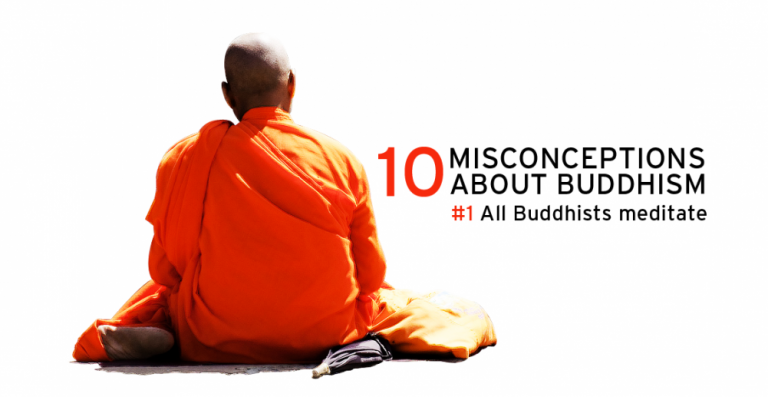The most common misconception about Buddhism is that all Buddhists meditate.
For over two millennia, Buddhists have made singular contributions to meditative theory and practice. Buddhist literature abounds in discussions about the stages of meditation, the prerequisites to achieving those stages, and the ways in which meditation serves to develop liberating insight. However, the majority of Buddhists throughout history have not meditated. Traditionally a monastic practice, meditation was even then considered a specialty of only certain monks. Furthermore, it is only since the 20th century that meditation has been considered a practice appropriate to teach to laypeople.
Related: Which Mindfulness?
Indian Vinaya literature—the collected regulations for monastics—says next to nothing about how meditation practice might have been institutionalized within the major monasteries. This pervasive silence suggests that meditation was not part of the daily routine of monks in large Indian monasteries; instead, these communities are portrayed as engaged primarily in recitation of texts.
For the most part, meditation seems to have been left to solitary ascetics (prahanika) who, living in the forest for months on end, seated at the roots of trees that served as their only shelter from torrential rains, must have appeared rather frightening to the sophisticated monks of India’s large urban monasteries. The Vinaya describes these ascetic meditators in consistently pejorative terms—as unkempt, slovenly, and uncouth—and prescribes rules related to their personal hygiene, such as requiring them to wash their feet at least once every three days.
When meditation is discussed in the sutra literature, the audience is invariably monks (and sometimes nuns), and very rarely laypeople. The implication is that meditation practice required such intensity, energy, and application that it was not something that the Buddha considered appropriate to teach to the laity.
This presumption is poignantly illustrated in the deathbed tale of the Buddha’s chief financial supporter, the businessman Anathapindada. As Anathapindada lies dying, the Buddha’s chief disciple Shariputra and his attendant Ananda go to minister to the major donor one last time. To help Anathapindada endure the dying process, Shariputra instructs him in “sensory restraint” (indriyasamvara) so that he remains unattached to his severe pain and develops a state of mind that clings to nothing.
At the end of Shariputra’s discourse, Anathapindada begins to weep. Ananda, concerned that this might be the end, asks him, “Are you sinking?” Anathapindada replies, “I am indeed sinking. But I’m more upset because, even though I’ve served the Buddha for many years, never once have I heard these teachings.” Shariputra remarks that such teachings are intended for the monks, not the laity, to which Anathapindada laments that there are laypeople “with little dust in their eyes” who would be able to make use of such instructions.
This exchange demonstrates quite movingly that meditation practice was not something that laypeople were typically taught; instead, charity (dana) was the religious practice incumbent on the laity, whose normative religious goal was rebirth in one of the heavens, not liberation from samsara.
Related: Our Common Thread
Even in Korean Buddhism, where Son (Zen) meditation has pride of place, monastic vocations are rigidly divided between practice monks (ip’ansung) and administrative monks (sap’ansung). The ip’ansung include monks engaged in full-time meditation practice in the meditation halls, as well as monks engaged in intensive textual study in Buddhist monastic seminaries. The sap’ansung include most everyone else, from the abbot (an administrative post in larger Korean monasteries distinct from the Son master, who is the spiritual head of the monastery), the prior, treasurer, and scribes (e.g., bookkeepers), to proctors, vergers of the various shrines around the monasteries, and bosses in the fields.
The sap’ansung are presumed to be too busy with their monastic duties to engage in formal meditation practice and are not even permitted to enter the meditation-hall compound, let alone sit with the full-time meditators. Thus, even in Korean Zen monasteries that are devoted to intensive meditation practice, only a minority of monks are actually engaged in meditation practice. And many of the most popular contemporary traditions of Buddhism, such as Nichiren Shoshu and Jodo Shinshu, do not place meditation at the center of their practice. Indeed, according to some Buddhist schools, during the current “degenerate age” it is impossible to achieve enlightenment through meditation.
According to both historical evidence and modern-day testimony, Buddhist monks have followed many vocations, of which meditation is but one (and probably a less common one at that). And it was only in the 20th century that laypeople in Buddhist traditions from Burma to Japan became regular practitioners of meditation.
[This story was first published in 2014]
Thank you for subscribing to Tricycle! As a nonprofit, we depend on readers like you to keep Buddhist teachings and practices widely available.
